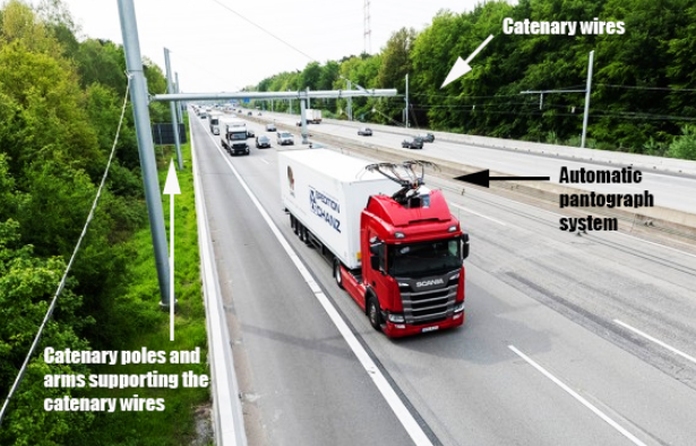
Researchers at the University of Cambridge have called for the electrification of 7,500km of the UK’s major road network to enable lorries to be powered by overhead charging cables.
A team from the Centre for Sustainable Road Freight (SRF), which brings together heavy vehicle engineering expertise from the department of engineering and logistics expertise from Heriot-Watt University and the University of Westminster and a consortium of industry partners, has proposed that building a so-called ‘electric road system’ could be used to decarbonise 65% of UK lorry kilometres travelled by 2040.
It claimed that the infrastructure could be built at an estimated cost of £19.3bn, using private finance
A report produced by the team, called ‘Decarbonising the UK’s Long-Haul Road Freight at Minimum Economic Cost’, set out the case for a nationwide rollout of the electric road system by the late 2030s, with the cost of the project (investment in electrification infrastructure such as catenary cables and substations) paid back over a 15-year period by charging hauliers for the electricity.
Powered by the national electricity grid, lorries driving on the inside lane would connect to overhead catenary cables through an automatic pantograph system – similar to those found on the top of electric trains. The electricity would power both the lorry’s electric motor and recharge its on-board electric battery.
The battery, which would be similar in size to an electric car battery, would enable the lorry to complete its journey away from the catenary system. Lorries would be free to leave the catenary wires to overtake, with the pantograph rapidly connecting and disconnecting automatically as needed.
The report’s co-author David Cebon, professor of mechanical engineering at the University of Cambridge and director of the SRF, said there was a “clear trend” towards battery electric vehicles for urban delivery that when combined with pantograph electric vehicles for long-haul freight and a decarbonised electricity grid, could achieve virtually zero greenhouse gas emissions.
Cebon said: “The economics are a triple win. The cost savings due to energy efficiency are sufficient to pay back the infrastructure investment in 15 years, the investment in pantograph electric lorries in 1.5 years, with enough left over for the government to replace its current income from diesel fuel tax with an excise tax on electricity sales.”
The report suggests that work on the first phase of a four-phase programme could start with an £80m pilot project in the North East of England, following in the footsteps of Sweden, Germany and Italy, where trials of electric road systems have already taken place. The trial could precede a first construction phase, starting as soon as 2026.
Comments
Comments are closed.











Surely the use of hydrogen fuel-cells as a power source for all vehicles, not just lorries, would be a far better solution – Catenary systems will not only be extremely costly to install and maintain, and unsightly, they will be prone to damage by poorly maintained lorry pantographs, damage which until rectified will leave lorries unable to utilize the system over effected lengths, with the rectification no doubt also involving lane closures for significant periods – Furthermore, all so fuel-cell powered vehicles, will not be limited to just using “main roads”!
Great project if it is funded by our various operators.
Its an interesting initiative. Does the need to have the possibility of two running lanes for those ‘smart motorways’ where the hard shoulder may or may not be open for traffic materially affect the costs and would that ‘encourage’ HGVs to use two lanes simultaneously? Many of our motorways do not have any (let alone intermittent) crash barriers to the near side; does the presence of frequent catenary support columns (as crash hazards) necessitate the additional installation of a continuous barrier?
It is essential to create a successful system to cut CO’2 and improve the environment. Due to the cost it would be good to get it right first time. Bravo to the think tanks, keep going
Is it not better to ease the pressure of long haulage transport on our roads by eliminating the potential dangers that cause horrific road accidents by bringing on the drones as a dynamic alternative……won’t be long before we can deliver by pallet eliminating road-trains and truckloads for safer roads, relieving congestion and reducing carbon monoxide. Some ideas are in the melting pot for drone ports around the coastlines for safety and sight pollution. Manoeuvring above shipping lanes but below flight paths with inbuilt trackers and sat navigation avoiding collision and traffic congestion. A paradigm shift for the new normal in logistics with speed enhancement.
In my opinion tax payers money would be much better spent with R&D, innovating a whole new method of transportation from A-B rather than incremental improvements on the ground. The skies the limit. Make it happen. Ben Martin
I tend to agree with other comments that this surely isn’t the best way into the future. What do you get for the same investment into the rail infrastructure which, unless I’m mistaken, is already largely electrified? Consider things like new rolling stock the size of 1, 2 and/or 3 articulated lorries, buzzing between hubs overnight and potentially unmanned. The hubs could also be charging stations for smaller scale local delivery vehicles. The whole thing contributes to reduced road traffic, with its associated noise and light pollution. I’d say this could also dovetail with the drone port idea suggested by Mr Martin and potentially extend this inland with designated drone routes over the rail routes outside of people transportation times.